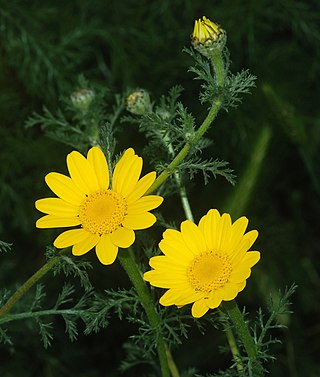
Cota tinctoria, the golden marguerite, yellow chamomile, or oxeye chamomile, is a species of perennial flowering plant in the sunflower family. Other common names include dyer's chamomile, Boston daisy, and Paris daisy. In horticulture this plant is still widely referred to by its synonym Anthemis tinctoria.

Asperula, commonly known as woodruff, is a genus of flowering plants in the family Rubiaceae. It contains 194 species and has a wide distribution area from Europe, northern Africa, temperate and subtropical Asia to Australasia.

Moenchia is a genus of plants in the family Caryophyllaceae with three species native to the Mediterranean region of southern Europe and naturalised in southern Africa and parts of North America and Australia. They are herbs, with an annual life span. They have slender roots and thin stems that are upright or ascending. Inflorescences are one- to three-flowered and terminally end the stems. The flowers are in spreading cymes or solitary, with bracts paired that are leaf like. Named after the 18th century German botanist Conrad Moench. A common name for the plants in this genus is upright chickweeds.

Echinops sphaerocephalus, known by the common names glandular globe-thistle, great globe-thistle or pale globe-thistle, is a Eurasian species of globe-thistle belonging to the tribe Cardueae within the family Asteraceae.
Galium hypotrichium is a species of flowering plant in the coffee family known by the common name alpine bedstraw. It is native to the western United States, where it grows in mountain and plateau habitats, including parts of the Great Basin and Sierra Nevada in California, Nevada, and Utah.
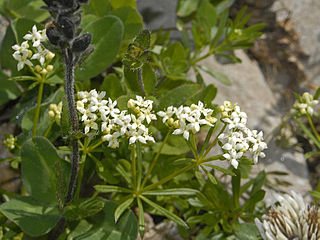
Galium anisophyllon, common name bedstraw or gaillet, is a flowering perennial plant in the family Rubiaceae.

Iris attica, the Greek iris, is a plant species in the genus Iris, it is also in the subgenus Iris. It is a rhizomatous perennial, from the mountains of the Balkans in Europe, within the countries of Greece, former Yugoslavia, Turkey and North Macedonia. It has sage green or grey-green leaves, that are sickle-shaped, a stout short stem and 2 variable flowers, in shades from yellow to purple. They have a white or blue beard. It is often called Iris pumila subsp attica, but is classified in most sources, as a separate species, although it is closely related to Iris pumila, as a possible parent plant. It is cultivated as an ornamental plant in temperate regions.
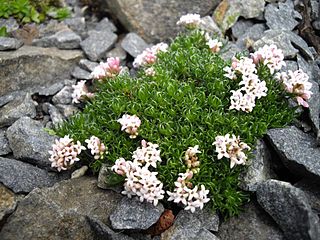
Asperula gussonei, also known as alpine woodruff, is a deciduous species of perennial groundcover, and a flowering plant in the family Rubiaceae. It was first described in 1831 and is endemic to Sicily.
Asperula mungieri is a species of flowering plant in the family Rubiaceae.
Asperula serotina is a species of flowering plant in the family Rubiaceae. It was first described in 1982 and is endemic to Turkey.
Asperula taygetea is a species of flowering plant in the family Rubiaceae. Asperula taygetea was first described in 1849 and is endemic to Greece.

Aquilegia ottonis is a species of flowering plant in the buttercup family. It has a broad distribution in Europe; it is native to Greece, Italy, and Albania. Plants produce blue-purple flowers which, based on pollination syndromes, are thought to be pollinated by bumblebees. A. ottonis is named after King Otto of Greece; the specific epithet 'ottonis' is the third declension of 'otto'.
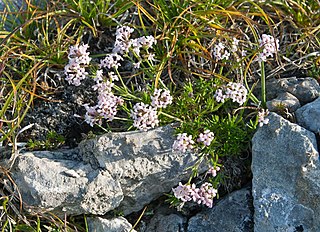
Asperula abchasica is a deciduous species of perennial groundcover, and a flowering plant in the family Rubiaceae, known as Woodruff, and is endemic to Transcaucasus, and was first named by V.I Krecz.
Asperula acuminata is a deciduous species of perennial groundcover, and a flowering plant in the family Rubiaceae, known as Woodruff, and is endemic from NE. Turkey to Transcaucasus, and was first named by Boiss. & A.Huet.
Asperula ambleia is a deciduous species of perennial groundcover, and a flowering plant in the family Rubiaceae, known as Stiff Woodruff, and is endemic from SE. Queensland to NE. Victoria in Australia, and was first named by Airy Shaw.
Asperula assamica is a deciduous species of perennial groundcover, and a flowering plant in the family Rubiaceae, known as Woodruff, and is endemic to Assam, East Himalayas, and was first named by Meisn.
Asperula asterocephala is a deciduous species of perennial groundcover, and a flowering plant in the family Rubiaceae, known as Woodruff, and is endemic to Iraq, and was first named by Bornm.
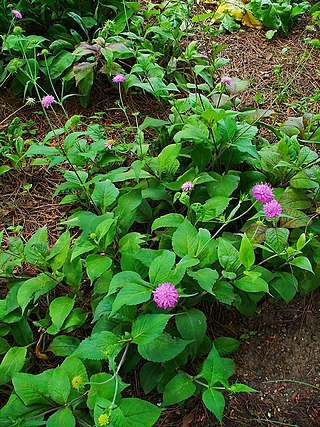
Knautia drymeia, commonly known as the Hungarian widow flower, is a herbaceous perennial plant species in the family Caprifoliaceae, that grows in Central and Southeastern Europe.
Thliphthisa is a genus of flowering plants in family Rubiaceae. It includes 22 species which range from southern Europe to Turkey, Cyprus, Syria, and Iran.










